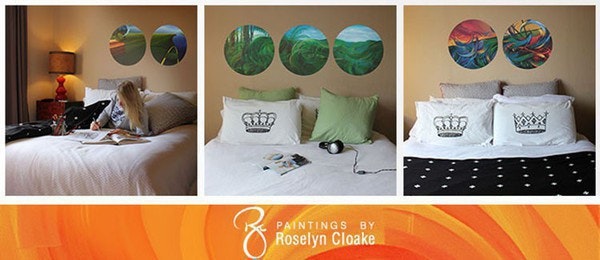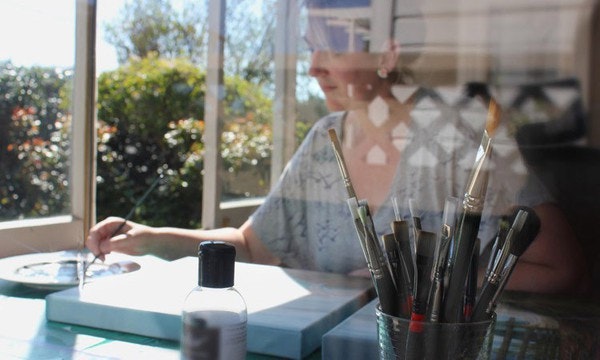
Alex: Could you tell our audiences who you are / what you do?
Roselyn: Hi I’m Roselyn Fauth (nee Cloake), my friends call me Rose. I love to crank the music and paint. It’s a great way to unwind and get my thoughts out on canvas. I have a 1 year old girl Medinella with my husband Chris. I run a graphic and web design company Cloake Creative with my father.
Before I was pregnant, I was a regular on the gig scene in South Canterbury with a solo project singing and playing mellow blues and jazz on my keys. (Here is a video of Roselyn performing.) and I was a member of a 7 piece funk soul band The Soul Agency. After the birth of our daughter, something had to give which was the music, so I have been working part time, and recently just managed to squeeze in time to paint.
The wall dots have been a really exciting way to get back into my art and find some new motivation. I take high resolution scans from my paintings and print them onto Happy Moose’s restickable wall dots.
Alex: So how did you start painting?
Roselyn: I guess in all honesty, painting was my retreat, it was a noisy house with 3 younger siblings, and cranking the music in my room and painting was a great way to clear my head and relax. After high school, I popped over to Holland to visit family and rediscover my roots. That’s when my dutch/kiwi painting series started. And in the last 4 years I have been painting more regional work, which I exhibit through Saffron Gallery of Art in Timaru.
My original part was painting my father's heritage and my mother's heritage and trying to figure out where I fit in the world. When you move, when you have a culture, two very strong cultures; sometimes you're not quite sure where you fit. The earlier series that I worked on was sort of in my early twenties and that's when I was trying to sort of evolve in my mind, was where my place is in the world, because I always used to say, "Ah, I'm a bit strange because I'm Dutch."
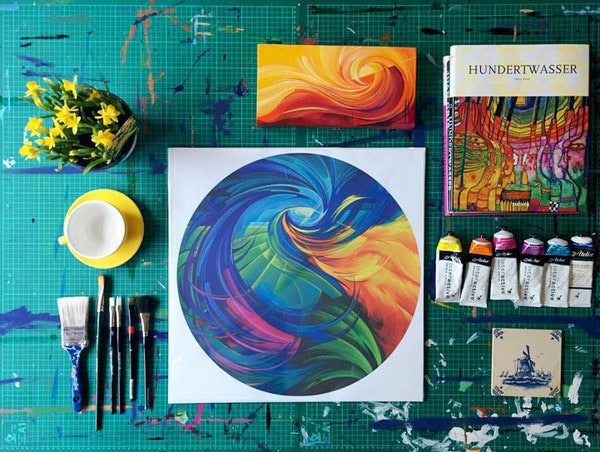
Yeah, because I'm from New Zealand, so there's that tension of you have your own culture that doesn't quite slide with everyone, sort of where those original paintings were coming from. I think that's also where a bit of the movement came from as well, because in my mind there was a bit of turbulence trying to figure out, you know? Interestingly, when I met my husband suddenly my paintings all became very calm.
I think that some of my work with these worlds, even though on a piece of paper I would say, "Well that's the wind, that's the sea," I think that's also been sort of where my head's been at at the time as well.
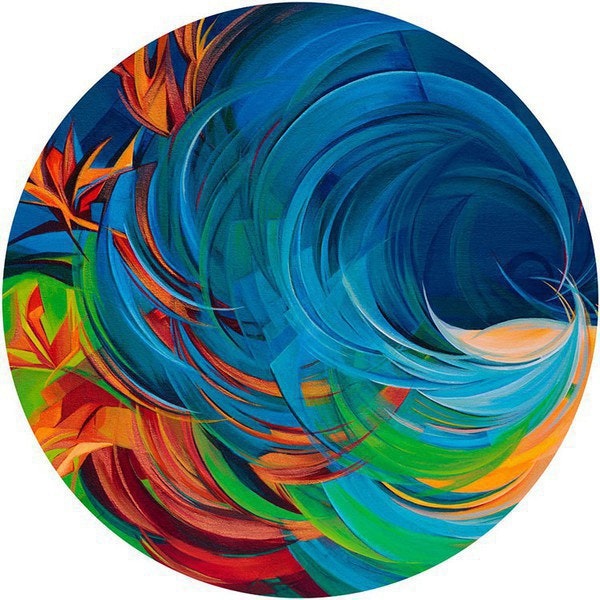

Alex: Will you like to tell us the story of this painting coaster? What is it about?
Roselyn: The coastal painting is a summary of feeling quite content and happy when you're out visiting the west coast. There's quite a feeling when you're over there, it's a different pace, and it's stunning.
When you're going up to Punakaiki and you've got just the whole cliff is just covered in orange flowers. It took my breath away; it was quite an exciting sort of landscape. That's what this painting has sort of evolved from.
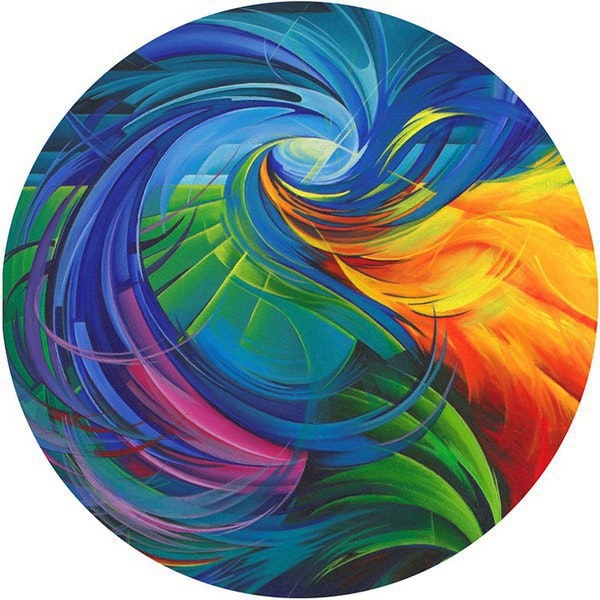
Alex: I heard that the Spun series are very popular. They are very vibrant and powerful images. What were you trying to say?
Roselyn: This painting could be interpreted in a few different ways. When I was looking at that series between my parents, my mother was symbolized by the windmills. For me, this painting is of a windmill. the idea of the windmill and it’s turning the sky into the tulips and it’s turning it into the grass. Yeah, it’s got a double kind of feeling and the idea of water, wind, earth, and fire.
That’s where a lot of that pink comes from those tulips in the field. I don’t know if you can see those bands of bright green that take you into the eye. It’s the idea of how, in Holland, when they plant out their fields, you have those rows of tulip colors. There’s a lot of that composition. The rows take you off into the distance. That’s where that comes from as well, just against the blades of the windmill moving and light pouring out of the eye.
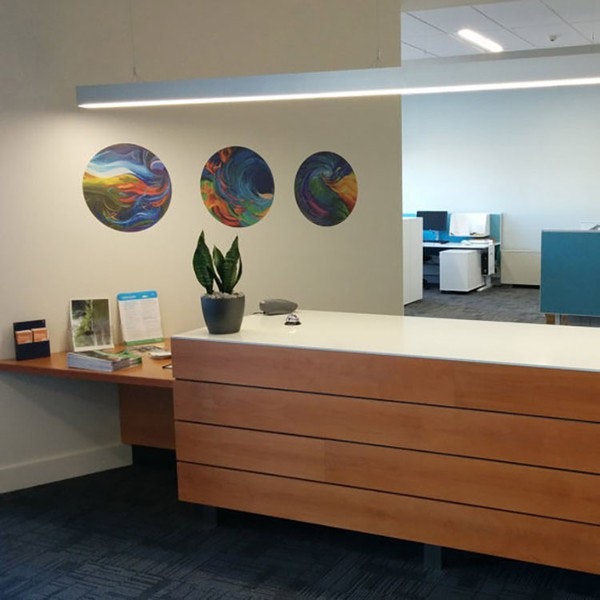
I think there’s a lot of things that people could find. I hoped with paintings like this that they wouldn't be boring. You could look at them and you could see different things every time you looked at them, which I think is an advantage that painters have over photographers. We can build, build, build lots of different detail and layers, and hopefully give people lots of things to keep coming back to.
Alex: When I first saw the tulips, I thought they were fire.
Roselyn: Yeah, I wanted to play on that idea as well. I quite like painting in a cyan magenta and yellow palette, not within the traditional red, blue, green. I think that’s probably from a graphic design background. You’re used to trying to work with that palette for printing. I think that’s why my colors are quite vibrant because, traditionally, when you mix with blue and green the colors can go quite muddy. You don’t have that with the cyan magenta yellow CMYK palette. This color is based loosely on that too.

Alex: How about this Forest-ed series?
Roselyn: Forest-ed is from three large square paintings, I got the idea when walking through the bush when we were in Doubtful Sound. The inspiration came when the breeze blows through the foliage.
I just tried to capture the feeling of how it can be quite still in the forest, and then you’ll hear that breeze coming through the rustling of leaves. Then you’ll feel it whistle around you and it swirls you with it. That’s what I tried to capture there was that feeling.
That was my biggest painting that I have done so far. This was recently printed as 3 x1m dots for an office wall. Very exciting to see these stuck to the wall.
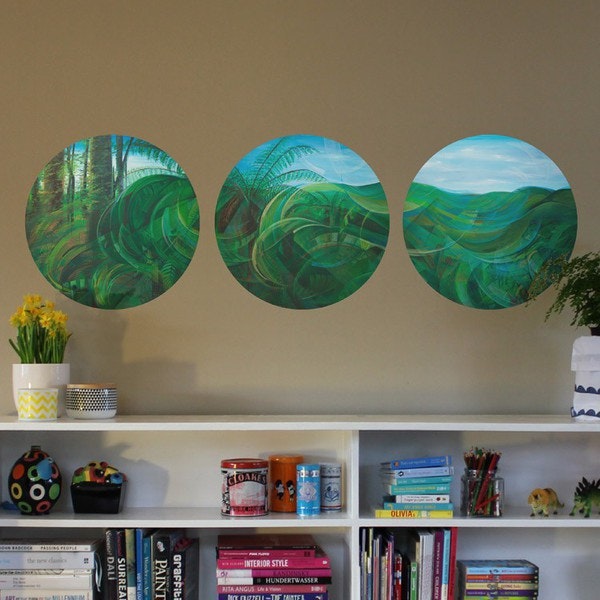
Alex: Those lines on the top. They are white cloud, are they?
Roselyn: I read a lot on Renaissance painting. I’m not quite sure exactly what the history behind it is, but often you will see that they paint bands of sky and there’s quite often seven. I guess there’s some sort of religious significance to that. There was one painting in particular which I can’t even remember now what it’s called, back from my high school years, where that was quit predominant through this artist’s style. I just quite liked it because it took away the focus of trying to have clouds that people recognized. They’re very hard to paint because even if you painted one perfectly they’re not always believable. People have an idea of what the sky looks like.
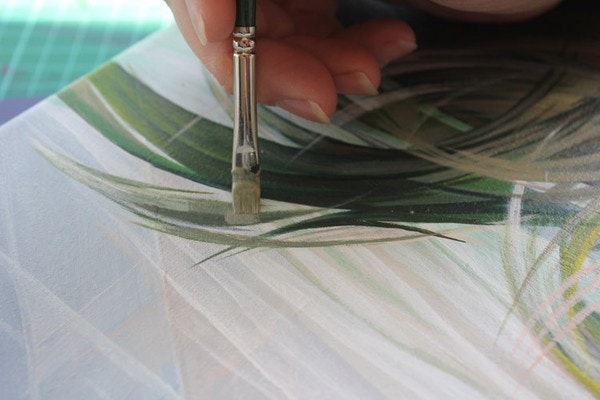
I quite like playing with the idea of those lines and I think it also helps to create a focal point. It holds the perspective together. I guess it could be seen as rays of light as well, when you have that sunset, and it streams through the cloud. I try to find an interesting way of bringing the sky and the land together.
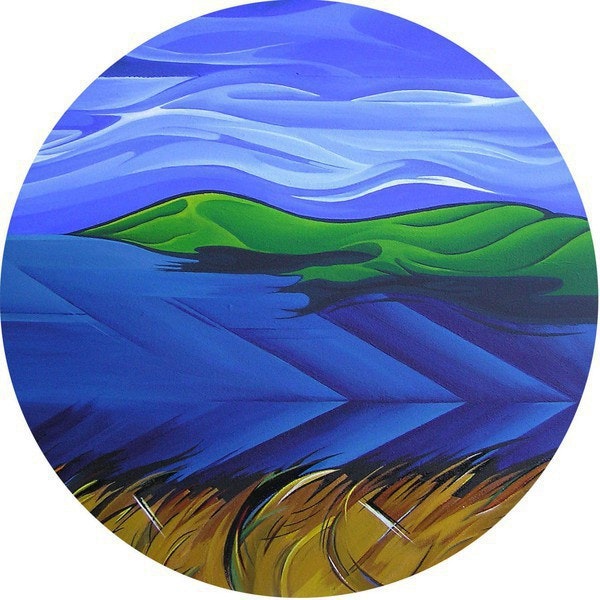
Alex: This one caught my eyes because the straight line is very unique. What’s the story behind it?
Roselyn: Maadi, is from my rowing days at Lake Ruataniwha when I used to row for the Timaru Womens Crew. Here the blades of a four sweep through the blue lake.
That painting is loosely Lake Ruataniwha and the idea of the blades of a four going past and disturbing the lake. Anybody who rows will know what Maadi is because that’s a massive rowing regatta that’s held every year for the high school students. As a fundraiser, I painted a series of paintings to go up at the regatta. The work they sold, the profit went back to the club as a fundraiser. That’s where that one came from. That’s for the rowing.
I wasn’t able to row in high school because I had glandular fever. I feel like I missed out on a lot of sport. After high school I went overseas to Holland for a year. I came back and then I joined the Timaru women’s rowing crew. The club didn’t really have senior rowers. It was all pretty much school based. That was quite a big part of my life for four years, huge fundraising as well. We fundraised to buy a new boat, which was I think about forty grand. A lot of time spent up at Lake Ruataniwha because that’s where the regattas were all summer. It started to feel like a second home and really, I loved it. I loved being up there.
The painting wasn’t designed to be cropped to circles. So it’s been quite exciting having an opportunity [working] with HappyMoose because I think it gives the painting a new lease of life, having that crop.

Alex: For the people who has purchased your dots, who are they and where do they put the dots?
Roselyn: It’s across the board really, I saw Happy Moose on Facebook and through I’d print a few for my own walls. I took a few photos and added them to Facebook, a few friends wanted them, then friends of friends etc… and now I have a website and Etsy page for people to order from. They are great in offices, homes… anywhere where you need a pop of colour for a great price.

Alex: We posted the above photo of your painting on Facebook and Instagram. The response has been overwhelmingly positive. As a painter, how do you differentiate your work when everyone has a camera in their pocket?
Roselyn: I think it is because the montage is not only visually pleasing, but it's also very different. It's visually like very, very different from any other photos you'll see on Instagram. I think that actually contribute a lot to the success of that particular image.
It's interesting we're coming back to the decor, some of my prints have been purchased by students, which I thought wasn't my market, because they wouldn't have the finance. I got them to take photos of their dorm rooms, which, as you can imagine, have got toilet paper rolls out there and booze and a hell of a mess and they actually have been really popular. They have the most views and I wonder if that's because we almost see so much polished imagery online that it's sort of blank out and suddenly you see a messy dorm room and then you think, "Oh, that's different."
Alex: For your new painting The Brunners, what did you do to share this process you’re your audience, not just the final painting?
Roselyn: What I've just done is I've almost finished a new painting, taking photos throughout the process and then my husband's photographed my hand as well. My plan is to do an animated GIF showing the process of it being painted and then I will get that printed on to a dot and then that's how I'll finish the GIF. Then people can see it was an original handcrafted painting that ends up being a sticker.
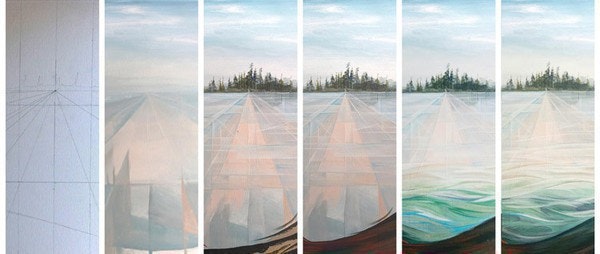
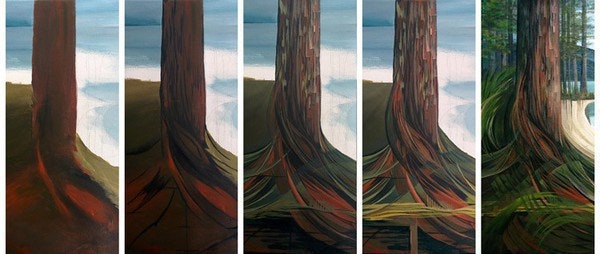
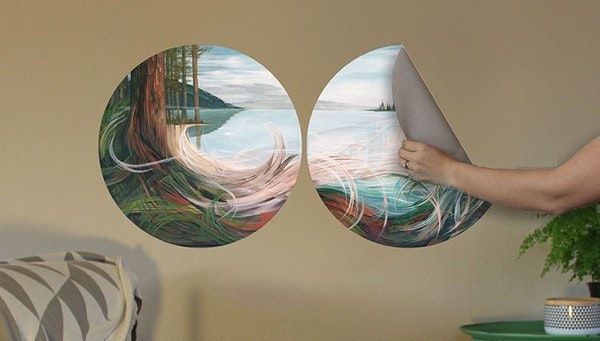
Now that I've got the dots, it's given me a bit more of an economical focus, but not worrying about it when I'm painting. I've found I can still enjoy the creative process and not think about it as a product and then I can do that with the dot and so that's been quite fun.
Alex: Is there an element of art you enjoy working with the most? Why?
Roselyn: Yes about 1/3 of the way through, the painting starts to come together and I get my confidence back that the painting is going to look and feel like I had intended.
Yeah. I mean I can say that it's all done on purpose, but I start off and I draw a graph and I go well there's my vanishing point. I turn on some great music and I say, "Well that's going to be my musical theme for the painting" and then it kind of just happens. I think I have everything in my mind, but it's not very planned. It just kind of evolves and I think that's something that just naturally happens. I think if I was trying to careful about what I was doing then I would lose the feeling of being free and the advantage of having that creative release as well.

Sometimes it's like if you're driving from Dunedin to Christchurch, you don't have to be careful what you're doing on the journey, sometimes you get Christchurch and you're like, "Oh my God, I don't remember the last two hours in the car." Sometimes my painting feels like that and I can get to the end of it and go, "Huh, how did I just do that?" Because you just get in to a bit of a daydream and you just relax.
I'm really careful what I listen to and I try to stay ... I try to listen to the same kind of music for the whole duration of the painting, because in the past I didn't and I would go from listening to Bach to then go into some free flow Jazz and it was a mess, so I had to go back and fix these things that were quite disjointed. I didn't realize that how much music was influencing me until I sort of looked at it. I think it's because subconsciously you start moving your hand to the music. It was probably some New Zealand R&B bands like Black Seeds.
Alex: Do you admire any artists / photographers? (Famous or not!)
Roselyn: Wow, where do I start! If I really have to narrow it down, the early cubist painters who painted the world as if looking through the facets of a crystal glass, are really interesting to me.
My dad Geoff Cloake is a fantastic photographer, after waiting for the light a lot as a kid (photographers will know what I mean by this) he taught me to hunt for compositions, to see colour, to see light. Part of my interpretation is the use of my father's cartooning techniques to portray movement and time. By incorporating this fourth dimension, I feel I have developed my own unique painting style.
I think, maybe fifteen years ago, I was really inspired the Cubist movement. They were looking at the world as if it was in facets of a crystal glass and I thought it was quite interesting how you could say, "Well, I actually like this angle and this angle and this angle, so we'll put all of them on a flat surface."
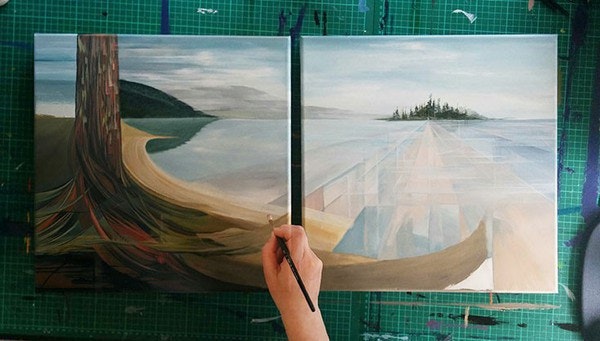
I started doing that and at the same time my father had actually decided he was going to learn how to draw cartoons and he'd actually gone to the Polytech just to do a cartoon night course for the hell of it, for a bit of fun. Then he ended up getting a contract to do cartoons for a New Zealand photography magazine, so quite often on a Sunday afternoon we'd all be sitting there trying to help him come up with jokes to draw about and we would see these cartoons progress. Of course a common way to say something's moving in a cartoon is to draw the lines, so I kind of thought ... I think it all happened subconsciously, it wasn't on purpose.
Looking at that Cubist idea and then looking at what my dad was doing to get movement in a cartoon and then two kinds of came together even more in the paintings. That sort of where that swish comes from. Then if you go back to some of those Canterbury artists over last sort of century, they have been painting the northeast winds turning all the tussocks and moving them at beaches. I think that's quite interesting as well. I think for me south Canterbury is never still. You've always got the easterly or the northwester or the southerly, so I think that's also why wind has sort of become a predominate thing that I've enjoyed to paint.
My uncle Gerd Jan Roos is a full time painter, he showed me some great painting techniques and foremost, that it is possible to live a life of art, something that wasn’t always encouraged at school as a career path.
Don Binny, Toss Wollaston, Rita Angus, Bill Hammond and Bill Sutton are my favourite regional painters.
If you like this interview, you may want to check out Roselyn's Homepage, her Facebook page Paintings by Roselyn Cloake or put through a couple of purchases from her online shop on Etsy.
